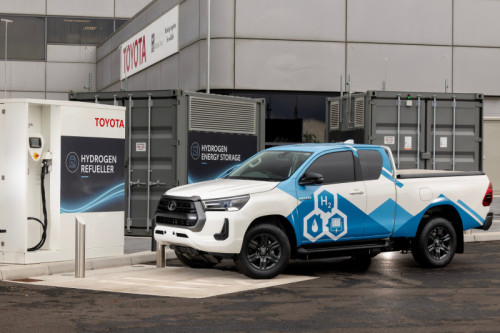In a significant step towards the goal of a carbon-free future, Toyota has introduced a prototype of the Hilux hydrogen fuel cell electric vehicle. The debut of this innovative vehicle is indicative of Toyota’s comprehensive strategy to attain carbon-neutral mobility by employing diverse powertrain solutions tailored to varying user requirements and global operating conditions. These solutions encompass hybrid electric, plug-in hybrid electric, battery electric, and fuel cell electric technologies.

The pioneering pickup truck was unveiled at Toyota Manufacturing UK’s vehicle plant in Derby, England. This achievement resulted from a collaborative effort between Toyota and consortium partners, bolstered by financial support from the UK Government. The Hilux, an emblematic global icon of the Toyota brand known for its exceptional reliability and durability, served as the platform for investigating the integration of a new zero-emission fuel cell electric powertrain while retaining its trademark qualities.

Drawing on the proven technology from the Toyota Mirai hydrogen fuel cell electric sedan, the novel powertrain offers the quality we expect from Toyota, backed by nearly a decade of commercial production experience. The fuel cell propulsion generates only pure water as emissions when in operation, and the vehicle stores hydrogen in three high-pressure fuel tanks.

The prototype Hilux is anticipated to have a driving range exceeding 370 miles, and we are curious whether additional fuel tanks may be available for those users, such as overlanders and commercial users, who regularly travel long distances. Positioned within the rear load deck, the hybrid battery efficiently stores electricity produced by the fuel cell onboard, eliminating the need for sacrificing cabin space.
How does a hydrogen fuel cell electric vehicle work? Good question.
Within the Proton Exchange Membrane (PEM) fuel cell, hydrogen molecules undergo a catalyst-induced separation, resulting in the formation of protons and electrons. Subsequently, the protons traverse a proton exchange membrane while the electrons are compelled to navigate an external circuit, leading to the production of electric power, which powers the vehicle.

Currently, hydrogen is nearly twice the cost of gasoline per gallon (2.2 pounds of hydrogen is equal to one gallon of gasoline) but, hydrogen is more than twice as efficient as gasoline and, if the $15,000/three year (on lease, for example) complimentary hydrogen fuel supplied by Toyota USA for the Toyota Mirai is an indication of the future, fueling a hydrogen fuel cell electric in the USA is quite affordable, at least in the short term. Interestingly, the only hydrogen refill stations currently listed on the Toyota USA website are to be found along the Pacific Northwest coast and nowhere else in the US. It is clear that, if and when this technology comes to the USA, there will need to be extensive infrastructure development, much like the consortium of EV manufacturers developing a charging network of at least 30,000 charging stations.

The Hilux hydrogen fuel cell electric vehicle’s project origins trace back to early 2022 when Toyota Manufacturing UK (TMUK) and Toyota Motor Europe embarked on a feasibility study. Subsequent funding from the UK Government’s Advanced Propulsion Centre, a non-profit entity supporting cleaner technology and novel mobility concepts, facilitated an intensive design and development initiative commencing in July 2022. Collaborative efforts between consortium members Ricardo, ETL, D2H Advanced Technologies, Thatcham Research, and Toyota Motor Corporation propelled the project forward.

The construction of prototypes commenced on June 5 of this year, adhering to Toyota Production System principles within a dedicated area of the TMUK facility. A mere three weeks later, the first vehicle rolled off the production line, marking the initiation of a series of 10 vehicles slated for completion by year’s end. Rigorous testing protocols ensure that safety, dynamic performance, functionality, and durability meet the exacting standards befitting a production model.

The endeavor has not only equipped TMUK personnel with expertise in fuel cell electrified vehicles and hydrogen system components but has also witnessed active engagement from consortium members during the initial phases. Ricardo played a pivotal role in preparing for prototype construction, overseeing design and development tasks, and aligning the manufacturing process with TMUK teams. Over the coming months, Ricardo will undertake a comprehensive evaluation of the vehicle, culminating in a decision on potentially introducing a production model in the latter half of this decade.
Read More: Will the New Toyota Land Cruiser Be the Vehicle We Want It to Be?
Our No Compromise Clause: We do not accept advertorial content or allow advertising to influence our coverage, and our contributors are guaranteed editorial independence. Overland International may earn a small commission from affiliate links included in this article. We appreciate your support.


